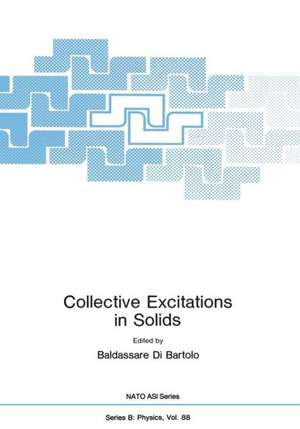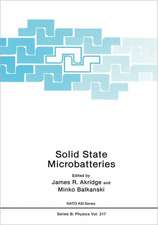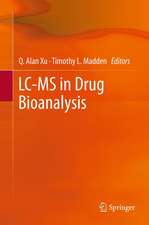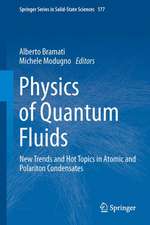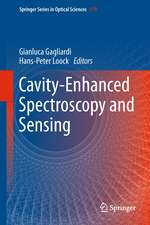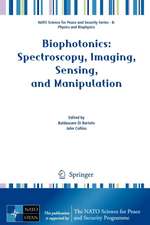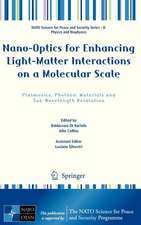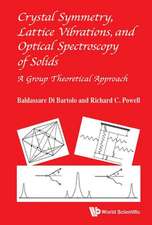Collective Excitations in Solids: NATO Science Series B:, cartea 88
Editat de Baldassare Di Bartolo, Joseph Dankoen Limba Engleză Paperback – 12 dec 2012
Din seria NATO Science Series B:
- 5%
 Preț: 375.70 lei
Preț: 375.70 lei - 5%
 Preț: 369.29 lei
Preț: 369.29 lei - 5%
 Preț: 720.84 lei
Preț: 720.84 lei - 18%
 Preț: 1406.03 lei
Preț: 1406.03 lei - 5%
 Preț: 373.33 lei
Preț: 373.33 lei - 5%
 Preț: 723.78 lei
Preț: 723.78 lei -
 Preț: 391.79 lei
Preț: 391.79 lei - 5%
 Preț: 1445.00 lei
Preț: 1445.00 lei - 5%
 Preț: 380.61 lei
Preț: 380.61 lei - 5%
 Preț: 1103.75 lei
Preț: 1103.75 lei - 5%
 Preț: 711.72 lei
Preț: 711.72 lei - 5%
 Preț: 1414.08 lei
Preț: 1414.08 lei - 18%
 Preț: 957.44 lei
Preț: 957.44 lei - 5%
 Preț: 723.21 lei
Preț: 723.21 lei - 5%
 Preț: 727.44 lei
Preț: 727.44 lei - 5%
 Preț: 1117.46 lei
Preț: 1117.46 lei - 5%
 Preț: 1423.55 lei
Preț: 1423.55 lei - 5%
 Preț: 366.56 lei
Preț: 366.56 lei - 5%
 Preț: 1116.21 lei
Preț: 1116.21 lei - 5%
 Preț: 1106.33 lei
Preț: 1106.33 lei - 5%
 Preț: 1107.77 lei
Preț: 1107.77 lei - 5%
 Preț: 1098.48 lei
Preț: 1098.48 lei - 5%
 Preț: 715.71 lei
Preț: 715.71 lei - 5%
 Preț: 1428.71 lei
Preț: 1428.71 lei - 5%
 Preț: 2004.54 lei
Preț: 2004.54 lei - 5%
 Preț: 724.70 lei
Preț: 724.70 lei - 5%
 Preț: 1438.38 lei
Preț: 1438.38 lei - 5%
 Preț: 1109.23 lei
Preț: 1109.23 lei - 5%
 Preț: 1414.64 lei
Preț: 1414.64 lei - 5%
 Preț: 1284.75 lei
Preț: 1284.75 lei - 5%
 Preț: 1023.26 lei
Preț: 1023.26 lei - 5%
 Preț: 388.12 lei
Preț: 388.12 lei - 5%
 Preț: 1104.48 lei
Preț: 1104.48 lei -
 Preț: 383.93 lei
Preț: 383.93 lei - 5%
 Preț: 718.46 lei
Preț: 718.46 lei - 5%
 Preț: 1113.63 lei
Preț: 1113.63 lei - 5%
 Preț: 369.45 lei
Preț: 369.45 lei - 5%
 Preț: 1108.72 lei
Preț: 1108.72 lei - 5%
 Preț: 1107.77 lei
Preț: 1107.77 lei - 5%
 Preț: 1297.99 lei
Preț: 1297.99 lei - 5%
 Preț: 1123.87 lei
Preț: 1123.87 lei - 5%
 Preț: 718.65 lei
Preț: 718.65 lei - 5%
 Preț: 2011.46 lei
Preț: 2011.46 lei - 5%
 Preț: 721.40 lei
Preț: 721.40 lei
Preț: 423.95 lei
Nou
Puncte Express: 636
Preț estimativ în valută:
81.13€ • 84.39$ • 66.98£
81.13€ • 84.39$ • 66.98£
Carte tipărită la comandă
Livrare economică 14-28 aprilie
Preluare comenzi: 021 569.72.76
Specificații
ISBN-13: 9781468488807
ISBN-10: 1468488805
Pagini: 740
Ilustrații: XXII, 716 p. 96 illus.
Dimensiuni: 178 x 254 x 39 mm
Greutate: 1.26 kg
Ediția:Softcover reprint of the original 1st ed. 1983
Editura: Springer Us
Colecția Springer
Seria NATO Science Series B:
Locul publicării:New York, NY, United States
ISBN-10: 1468488805
Pagini: 740
Ilustrații: XXII, 716 p. 96 illus.
Dimensiuni: 178 x 254 x 39 mm
Greutate: 1.26 kg
Ediția:Softcover reprint of the original 1st ed. 1983
Editura: Springer Us
Colecția Springer
Seria NATO Science Series B:
Locul publicării:New York, NY, United States
Public țintă
ResearchCuprins
Quantum Mechanical Description of Solids.- Abstract.- I. Introduction.- II. Adiabatic Approximation.- III. HartreeFock Approximation.- IV. Electronic Bands in Crystals.- V. Lattice Dynamics as Collective Excitations: Phonons.- VI. Collective Excitations of Electrons: Plasmons.- VII. Extrinsic States.- VIII. Some Effects of Applied Stress.- IX. Conclusions.- References.- to Collective Excitations in Solids.- Abstract.- I. Interactions in a TwoLevel System.- II. Collective Excitations.- III. Interaction of Radiation with Collective Excitations.- IV. Propagation of Radiation in a Dispersive Medium.- V. Examples of Collective Excitations.- References.- Quasi-Particles and Excitons: Models of Structure and Correlation.- Abstract.- I. Introduction.- II. Basic Concepts of Quantum Field Theory.- III. Models.- IV. Conclusions.- References.- Coherent Wavepackets of Phonons.- Abstract.- I. OneDimensional Elastic Line.- II. Beyond the Model of a Chain of Masses and Springs.- III. Motion of a Pulse in the Classical Limit.- IV. Motion of a Pulse in Quantum Mechanics.- V. Birth and Death of a Pulse.- References.- Appendix A: The Coherent States.- Appendix B: The Poisson Distribution.- References.- to Exciton Physics.- Abstract.- I. Introduction.- II. Electronic Structure.- III. Interactions with Phonons.- IV. Interactions with Photons.- V. Kinetics and Dynamics at Low and Intermediate Densities.- Acknowledgements.- References.- Excitons in Semiconductors.- Abstract.- I. Basic Properties of the Free Exciton.- II. Introduction to Bound Excitons.- III. Bound Exciton Satellite Structure.- IV. High Excitation Intensity Effects.- References.- Excitons in Insulators.- Abstract.- I. Introduction.- II. Theoretical and Experimental Background.- III. Excitons in Alkali Halides.- IV. Excitons inRare Gas Solids.- V. Concluding Remarks.- References.- Inelastic Scattering of Fast Particles by Plasmons.- Abstract.- I. Introduction.- II. Bulk and Surface Plasmon Hamiltonian.- III. Charge Particle Spectroscopies of Plasmons.- References.- From Magnons to Solitons.- Abstract.- I. Introduction.- II. Magnons.- III. MagnonMagnon Forces.- IV. TwoMagnon Bound States.- V. ManyBody Scattering Theory.- VI. XY Model: A Model Antiferromagnet.- VII. Heisenberg Antiferromagnet: Ground State.- VIII. Some Consequences.- IX. Effects of Surfaces on Magnons.- X. Magnons vs. Solitons.- XI. Soliton Solutions.- References.- Quasiparticles in Magnetic Metals.- Abstract.- I. Introduction.- II. Low Density Electron Gas.- III. Criterion for Magnetic Ground State.- IV. Quasiparticles.- V. Nearly HalfFilled Band: Nagaoka’s Theory.- VI. Two or More Magnetic SubBands.- VII. Magnons in Metals.- VIII. Antiferromagnetism in Metals.- Polaritons.- Abstract.- I. Introduction.- II. Bulk Polariton Linear Response.- III. Experiments on Bulk Polaritons.- IV. Surface Polariton Linear Response.- V. Experiments on Surface Polaritons.- VI. Conclusion.- References 49.- Polarons.- Abstract.- I. Introduction.- II. The LandauPekar StrongCoupling Theory.- III. FieldTheory Formalism, Fröhlich’s Hamiltonian and WeakCoupling Theory.- IV. Other Methods for Large (Fröhlich) Polarons.- V. Small Polarons and SelfTrapping.- References.- Long Seminars.- Surface Collective Excitations.- Collective Excitations in Concentrated Mn2+ Systems: Spectral Properties.- Optical Dynamics in Concentrated Mn2+ Systems.- Spectroscopy of Stoichiometric Laser Materials: Excitons or Incoherent Transfers?.- Exciton-Hole Droplets in Semiconductors.- Excitons and Plasmons: Collective Excitations in Semiconductors.- Picosecond ExcitonPhenomena in Chlorophyll Complexes (Abstract only).- Bose-Einstein Statics in Exciton Systems.- Small Polarons in Biological Systems (Abstract only).- Short Seminars (Abstracts).- Perspectives of Free Electron Lasers in Solids.- The Dispersion Curves of Excitonic Polaritons and Their Distortion with Increasing Density.- Motion of a Magnon Soliton About a Phonon Soliton in a Onedimensional Ferromagnet.- Interconfiguration Fluctuations.- Luminescence of Mn2+ IN RbMnxMg1xF3.- Effect of Hydrostatic Pressure on the Luminescence Spectra of the S2 Centre and the EPR of This S2 Centre for the Crystal Scapolite.- On the Calculation of Polaron Wavefunction in the Static Electronlattice Coupling.- Semiconductor Surface Inversion Layers and Their Collective Modes.- Concluding Article.- Present Trends in Collective Excitations in Solids.- Contributors.
